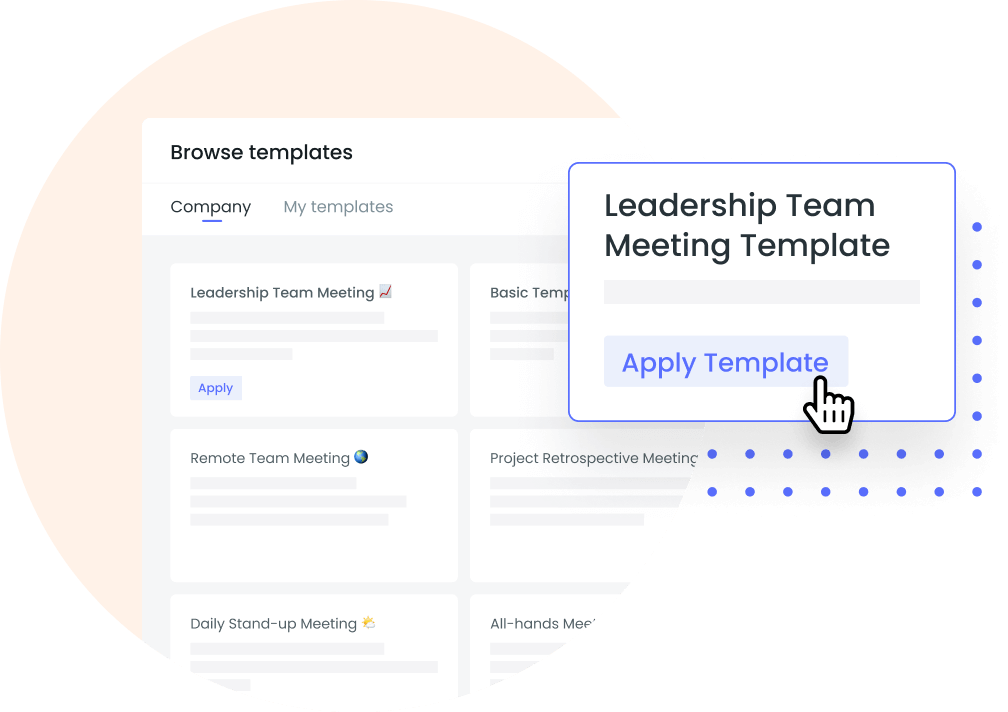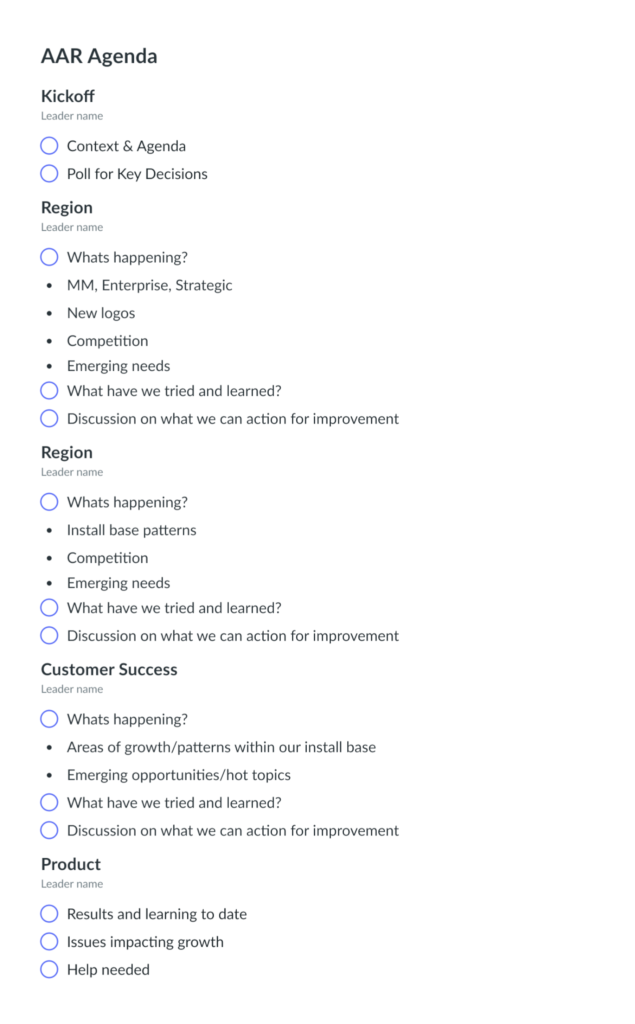After Action Reviews: 7 Best Practices [+ Free Template]
Learn how to implement the After Action Review system to transfer critical lessons and knowledge into your daily life.
When you think of the military, you likely think of a formal system that reinforces discipline so a group can reach specific goals. Or maybe you imagine a culture grounded in loyalty, integrity, and respect. Either way, one can learn a lot from military processes and even borrow certain practices to use in work and everyday life.
Some businesses have adopted the After Action Review (AAR) process that was developed by the military as a way for everyone to learn from soldiers’ experiences on the field.
Read on if you want to learn more about the AAR process and its benefits, explore seven best practices, and get a free AAR template.
- What is the After Action Review (AAR) process?
- Benefits of an AAR
- 7 AAR best practices
- Free ARR template
What is the After Action Review (AAR) process?
The AAR process allows companies to evaluate tactics along the way to set teams up for success. It’s used to debrief a task, project, or event, determine why things happened the way they did, and highlight areas of strength and concern within the group. With this process, knowledge and important lessons are transferred immediately so everyone benefits from feedback at the time it’s given.
There are four key phases to the AAR process:
- Design: In the first part, the group identifies all stakeholders and involved individuals, and identifies the key details of the AAR.
- Prepare: The second part of the process involves conducting research on your project and planning what activities need to be carried out for the AAR.
- Implement: In the third phase, the group analyses and begins the reflection of the AAR.
- Disseminate: The last phase of the AAR is to sort through findings, write up a report, and create a plan to move forward with your new information.
It comes as no surprise that the AAR process was developed by the military. AAR is commonly used to help soldiers process events, establish why an outcome occurred, and determine how they can sustain strengths and improve on weaknesses in the future.

Run productive AARs
Level up your meeting habits to boost engagement and productivity with a collaborative meeting agenda. Try a tool like Fellow!

Benefits of an AAR
- Helps identify issues
- Encourages more feedback
- Fosters a learning-focused environment
- Improves processes
- Enhances communication and collaboration
1Helps identify issues
While you can’t control every possible risk, you can manage them with an AAR. AARs help teams and individuals identify issues or opportunities for a project so adjustments can be made in real time. When you identify issues at the beginning or midway through a project rather than at the end, you can more easily manage challenges and modify timelines and resources accordingly so they align with what is needed to make the project successful.
2Encourages more feedback
Feedback is the key to a strong and healthy workplace culture. An AAR is a perfect time to give and receive meaningful feedback. During the AAR process, you will determine what has occurred so far and what needs to occur for your project to be successful. At this time, you should ask for feedback about your performance and give some to your colleagues as well so that everyone can optimize their work.
Pro tip: A healthy and strong culture starts with feedback. Fellow enables your team to share real-time feedback on meetings, projects, and performance.

3Fosters a learning-focused environment
AARs are learning-focused discussions, meaning that they provide an opportunity for teams to discover what they can do differently to turn goals into reality. For example, after a team-building exercise with your team, you can complete an AAR to analyze what you can do to collaborate moving forward. You may discover from the experience that you need to prioritize open communication at times of high stress or learn that certain teammates are skilled tactical executors while others are strategic thinkers.
4Improves processes
The ultimate goal of an AAR is to make future tasks and projects better. AARs can also make company processes highly effective and more productive. For example, you may learn from an AAR meeting that you could be using software to automate repetitive tasks that individuals are doing manually. The AAR process will also help you remove inefficiencies in workplace processes, therefore helping improve your team’s workflow.
5Enhances communication and collaboration
Any methodology that enhances team communication is an effective one. The AAR process emphasizes skillful questioning, meaning that teammates must carefully discuss details of projects and keep everyone up to date on tasks as they get completed. The better team members can collaborate and work through challenges, the better off they’ll be in the long run.
7 AAR best practices
- Communicate a clear purpose to the AAR
- Use a meeting agenda template
- Assign meeting roles
- Be timely
- Encourage participation
- Provide time for a Q&A period
- Take meeting minutes
1Communicate a clear purpose to the AAR
Before you decide to use an AAR process to guide a project or task, send a note to all involved individuals. The message should outline what an AAR process is and how you can use it to set your team up for success. The purpose should be a clear statement of what you hope to accomplish and how. The purpose of the meeting can also help you identify participants who need to attend. For example, if the purpose of implementing the AAR process is to monitor and improve the implementation of your company’s new brand standards, you may want to include members of the marketing team, senior leadership, and anyone else working on the project.
2Use a meeting agenda template
A meeting agenda should be distributed before every meeting and AARs are no exception. Your collaborative meeting agenda should include specific talking points and topics, establish the meeting type, state the objective, and include a list of necessary documents. Share the agenda at least 24 hours in advance of the meeting so participants can add their own notes and talking points as well.
Did you know that Fellow has a variety of meeting agenda templates that you can use to host productive sessions with your colleagues? Try one out the next time you want some help to guide a discussion!

3Assign meeting roles
The person leading the meeting should be the person in charge of assigning meeting roles. Some common meeting roles include the organizer, host, notetaker, timekeeper, decision maker, the voice of the customer, and informed participants. No more than one or two individuals should be responsible for keeping the AAR process on track during a meeting to avoid complications.
4Be timely
The best feedback is given as things happen. For your AAR to be effective, it must be timely. The AAR should start when you begin your project and last the duration of your task’s timeline. For example, as you begin the project, you’ll likely come into the review process with a basic idea of things you’re looking for or lessons you hope to walk away with. From that point, you can tackle the preparation stage and continue the AAR process alongside the project life cycle.
5Encourage participation
The success of an AAR process depends on the participation of a group. For that reason, everyone participating in the process needs to be comfortable giving their opinion and feedback. Create a psychologically safe environment where everyone can speak up, share ideas, ask questions, and make mistakes without fear of retribution.
One of the best ways to encourage participation in a meeting is by sharing a collaborative agenda in advance. When you allow participants to prepare, you empower them to speak up and bring their ideas to the table. Try one of our 500+ meeting agenda templates to level up your AAR process today!
6Provide time for a Q&A period
Leave room for a Q&A period following each meeting that’s part of your AAR process. Remain open-minded, as there are no right or wrong questions for participants to ask during this time. Encourage open questions so you and the group can answer with more information and contextual feedback. Some questions that may be asked include: What should we do differently next time? How could the situation have been prevented? What can we do now to get a step closer to the goal we’re trying to reach?
7Take meeting minutes
During each meeting related to your AAR process, take a written record of the conversation and decisions made. These meeting minutes should include enough detail that they inform team members who couldn’t attend and keep track of decisions and action items from the meeting. Think of meeting minutes as proof of why and how you came to certain decisions.
Free ARR template

Parting advice
The AAR process is an excellent way to improve communication and feedback within a team. Remember that you aren’t limited to using AARs for large or formal projects. You can use them following staff meetings or to optimize usual operational functions.
Unsure where to start? Begin by having an open and honest conversation with your team about how you plan to approach upcoming goals and work from there!










